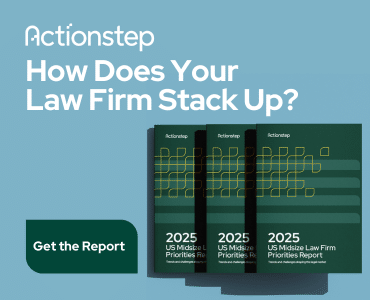“Share of Model” evaluates how visible your firm is to AI models like ChatGPT and Google’s automatically generated AI overviews — and it will have increasing importance for lawyers in the years ahead. Here’s your need-to-know — and the steps to take.

Table of contents
You might be familiar with “Share of Voice,” the public relations metric that measures how visible an organization is in its market compared with its competitors.
In the brave new world of ubiquitous AI, there’s a variation of that metric called “Share of Model,” which will have increasing importance for lawyers in the years ahead.
What Is Share of Model?
While Share of Voice assesses your firm’s presence in relevant earned media and social media, Share of Model evaluates how visible you are to AI’s large language models (LLMs), such as ChatGPT, Perplexity and Google’s automatically generated AI overviews.
In short, Share of Model will help you understand how — and if — LLMs are finding and recommending your firm when users ask questions in your specific field or practice area.
Why Does Share of Model Matter for Lawyer Marketing?
More of your potential clients are turning to LLMs to find lawyers and to answer their legal questions. Instead of entering “family lawyer in Fargo” in a search engine, they might ask ChatGPT to make a short list of local divorce attorneys. Indeed, ChatGPT now boasts 180 million daily users, handling more than 1 billion queries per day.
Most users are young adults and professionals, with more than half between 18 and 34 years old; this is your next generation of clients (and associates).
Moreover, your firm’s visibility in LLMs matters even to potential clients who don’t log on to ChatGPT. Thanks to Google’s integration of AI overviews into its search engine results, its AI-generated response will typically be the first answer they see; people scouting firms on Google are increasingly less likely to view those page-one listings you worked so hard for. In fact, one study showed Google’s AI overviews dropping click rates for the top-ranking pages by 34.5%.
What to Do: A Step-by-Step Plan for Increasing Share of Model
Here’s how to up your game in the age of LLMs and Share of Model.
First: Get specific.
Before you set out to measure Share of Model, get specific:
- What are the AI queries that matter most to you?
- What are the conversations that you should be in, given your practice focus, geographic reach and capabilities?
- And are these questions your prospects may actually ask?
This may mean the firm scales back from working to rank in “family law” to owning “Des Moines divorce lawyers,” courting users who ask things like:
- Who are the best divorce lawyers in Des Moines?
- What are the best divorce law firms in Des Moines?
- Please prepare a short list of divorce attorneys in Des Moines.
Then: Determine your starting Share of Model.
You can take a DIY approach and do this manually, or you can use a tool that automates the process for you.
To do it manually:
- Identify the relevant LLMs. Determine which LLMs your target audience is likely to use, such as ChatGPT and Gemini.
- Develop test queries. Ask the questions you outlined above (and variations thereof).
Key tip: Make sure to ask your LLMs for sources, so you can see where they are getting their material. - Document and analyze LLM responses. Run your test queries and watch for brand mentions (how often you are named), brand sentiment (how favorably you are portrayed), and the competitive landscape (which competitors are also mentioned, and how their descriptions compare with yours).
Make sure to chart which sources the LLMs are citing. (We’ll refer to this later.)
Alternatively, you can use a product like Jellyfish’s Share of Model, Rankscale.AI or Peec.AI to do this for you. In addition to saving you valuable time, Share of Model software output may be more reliable, as it’s able to run multiple queries each day and rotate IP addresses daily to avoid the bias possible when an AI model gets to “know” you.
Next: Create your to-do list.
Refer to the list of sources the LLMs referenced in your manual roundup or in your software’s reporting.
Ask these questions:
Are the LLMs crawling our site? Are we seeing our home page, practice pages, lawyer biographies or articles in the list of sources? Just as we optimize websites for SEO, you may need to retool your website content and structure for AI visibility. (This is a rapidly evolving field and another article altogether.)
How do we perform in the cited awards and directories? So far, we are seeing LLMs rely heavily on lawyer directories, such as Avvo, and legal sector awards and rankings, like Super Lawyers, Chambers and Best Law Firms.
Example: Using Peec.AI, I created a report using the “Des Moines divorce lawyers” hypothetical we discussed. Super Lawyers was referenced in 83% of ChatGPT output.
Which of these pages are cited in your results, and where do you have room to improve?
What kinds of content are other firms leveraging? For Google AI overviews, in particular, often the answers are not limited by the literal question; the LLM seeks to provide additional helpful context based on the user’s intent. If the user is searching for a patent lawyer, the LLM may give resources on the patent process or the U.S. Patent and Trademark Office along with firm recommendations.
Example: In the “Des Moines divorce lawyers” scenario, Google AI referenced material from a Los Angeles firm, “Are There Different Kinds of Divorce Lawyers,” along with an article that was at least Iowa-adjacent, “How to Choose the Right Divorce Lawyer in Wisconsin.”
What kind of material could you add that would help a layperson start their search for a lawyer in your field? (A good place to start: What are the questions you get asked by real people repeatedly? What do you wish your new clients knew?)
Execute and Repeat
Implement your to-dos, and repeat Step 2 on a regular basis to track your success.
Remember that these models — just like AI at large — are changing quickly. Be open to running smart experiments and be ready to pivot and adapt.
©iStockPhoto.com
More From Attorney at Work
Keys to Using GenAI in Your Law Practice? Caution and Common Sense
Image © iStockPhoto.com.

Sign up for Attorney at Work’s daily practice tips newsletter here and subscribe to our podcast, Attorney at Work Today.
















